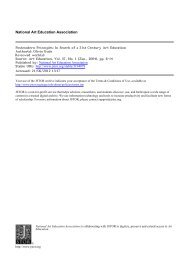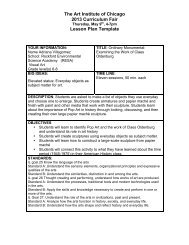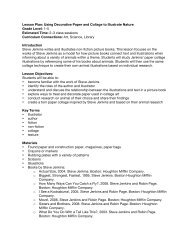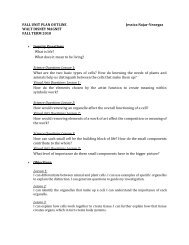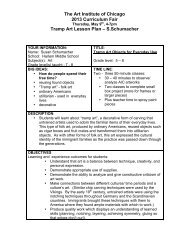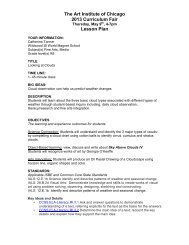Lesson 1 - LearningThroughMuseums
Lesson 1 - LearningThroughMuseums
Lesson 1 - LearningThroughMuseums
Create successful ePaper yourself
Turn your PDF publications into a flip-book with our unique Google optimized e-Paper software.
main idea<br />
mood<br />
scale<br />
technique<br />
urban<br />
● Procedure<br />
Part 1: Reading a Painting<br />
1. Show students The Coffee House by Alson Skinner Clark. Explain that it is called The Coffee<br />
House not because it shows a coffee shop but warehouses to store manufactured products, like<br />
coffee.<br />
2. Ask students to describe what they see in the image. What do they notice?<br />
3. Give students the Art Reader organizer to complete in think-pair-share structure. Guide students<br />
to complete each part so that they make notes individually on the Art Reader, then pair<br />
with a partner, and then share as you guide a class discussion.<br />
4. Emphasize the use of techniques, such as the way the artist chooses to use color, line, or shape,<br />
to create a mood. First, ask students what mood they inferred. Then discuss how the artist used<br />
these elements (color, line, shape, or scale) to create that mood.<br />
Part 2: Inferring the Main Idea and Charting an Extended Response<br />
1. Explain that interpreting a painting is like interpreting a poem or story. You need to take time<br />
to think about what the painter included and then think about what the painter wants you to<br />
understand.<br />
2. Guide students to infer one main idea, which is a part of their interpretation, from the painting.<br />
Point out that you can infer the main idea of a story or poem by noticing what the writer<br />
emphasizes.<br />
3. Have students complete the Main Idea Interpreter in think-pair-share structure. Also ask them<br />
what title (besides The Coffee House) they might give the painting that would tell its main idea.<br />
4. Give students the Extended Response organizer and explain that The Coffee House was painted<br />
more than 100 years ago. Ask them to prepare a compare and contrast Extended Response<br />
Chart based on the painting and their own experience.<br />
5. Have students keep their charts to use to write the extended response on Day 3 of the lesson.<br />
Part 3: Writing an Extended Response Based on a Painting<br />
1. Students use their charts from the previous day to write the extended response.<br />
2. Students exchange their extended responses and underline the information that the other<br />
students included from the painting and circle the information that students included from their<br />
experience.<br />
68 • <strong>Lesson</strong> 4: The Midwest ‒ The City and the Farm



